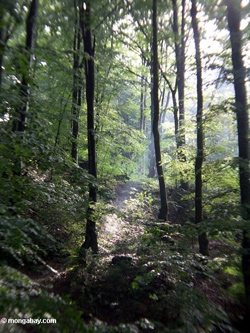European Union forests expanding, absorbing carbon rapidly
European Union forests expanding, absorbing carbon rapidly
University of Helsinki
November 29, 2007
European Union countries likely require an old ally — Mother Nature and her forests — to meet an ambitious post-Kyoto goal for cutting greenhouse gas emissions 20% by 2020, according to new research.
The University of Helsinki study says that despite rising population and affluence, the EU can meet its obligations post-Kyoto (2012-2020). However, it will likely require more than energy savings, new technologies and mitigating non-CO2 gasses such as methane; partial credit for expansion of the region’s forests could be decisive, say researchers Pekka E. Kauppi, Laura Saikku and Aapo Rautiainen, whose report, The Sustainability Challenge of Meeting Carbon Dioxide Targets in Europe by 2020, is published today in the peer-reviewed UK journal Energy Policy.
 Forest in Slovenia. Photo by Rhett A. Butler European blood-sucker falls victim to global warming Europe’s only known land leech may be on the brink of extinction due to shifts in climate, report researchers writing in the journal Naturwissenschaften. The findings are significant because they suggest that “human-induced climate change without apparent habitat destruction can lead to the extinction of populations of cold-adapted species that have a low colonization ability,” according to the authors. Alps could lose 80% of glacier cover by 2100 The European Alps could lose 80 percent of their glacier cover by the year 2100, if summer air temperatures increase by three degrees Celsius (five degrees Fahrenheit) according to a study published in Geophysical Research Letters, a journal of the American Geophysical Union. |
The study finds that between 1990 and 2005, expansion of above-ground tree vegetation in the 27 EU countries annually absorbed an additional 126 teragrams (126 million tonnes) of carbon — equal to 11% of the region’s emissions.
The rate varied from 10% in the 15 old member states (Austria, Belgium, Denmark, Finland, France , Germany, Greece, Ireland, Italy, Luxembourg, Netherlands, Portugal, Spain, Sweden, UK) to 15% in the 12 new members (Bulgaria, Cyprus, Czech Republic, Estonia, Hungary, Latvia, Lithuania, Malta, Poland, Romania, Slovakia, Slovenia).
The findings were surprising, says study leader Prof. Kauppi, who with colleagues in 1992 estimated the rate of increase of CO2 absorbsion through the expansion of forests at no more than 5%.
The study shows that total CO2 sequestered by EU forests relative to national emissions varies widely from country to country. In Latvia, for example, forests more than offset per capita emissions. And forests in Lithuania, Sweden, Slovenia, Bulgaria and Finland absorb a large part of national emissions. At the other end of the scale are lightly-forested countries such as Belgium, Ireland, the Netherlands, Cyprus and Denmark.
The new paper builds on work reported last year by Prof. Kauppi and international collaborators, who revealed the shift from deforestation to afforestation in the world’s most forested nations. They advanced a more sophisticated approach to measuring forest cover that considers not just forested area but density of trees per hectare.
Their “Forest Identity” calculation also quantifies the biomass and atmospheric carbon stored in forests. They reported that, amid widespread concern about deforestation, growing stock has in fact expanded over the past 15 years in 22 of the 50 countries with most forest, including several EU members.
“The good news is that trees are extremely efficient mechanisms for capturing and storing carbon,” says Prof. Kauppi, a member of the Nobel-laureate UN International Panel on Climate Change. “The better news is that Europe’s forests are thriving and expanding and therefore will play an increasingly important role in helping the EU to reach its environmental goals.”
“Every year, the expanding European forests remove a surprisingly large amount of carbon from the atmosphere,” says co-author Aapo Rautiainen. “According to rough estimates, their impact in reducing atmospheric carbon may well be twice that achieved by the use of renewable energy in Europe today.”
Under the Kyoto Protocol, the EU commited to an 8% reduction of annual greenhouse gas emissions by 2012, using 1990 as the base year. Under the protocol, countries do not get credit for increasing natural carbon sinks through forestry and agriculture. Negotiations on an accord to cover the post-Kyoto period 2012 to 2020 are underway.
The researchers note the daunting challenge confronting EU nations in order to meet a post-Kyoto commitment to reduce emissions 20% from 1990 levels by 2020: a dramatic reduction of energy used per unit of GDP and de-carbonization of energy supply against a backdrop of rising population and affluence.
CO2 emissions in EU nations grew by an average of roughly 1% every three years between 1992 and 2004. To reduce CO2 emissions in EU27 by 20% in the next 12 years, carbon emission per economic output needs to at least halved (49 to 64% depending on the growth of population and economy).
The report’s authors note that Europe-wide emissions have not yet started to decline and that time is running out for the EU to successfully embark on it ambitious 2020 goal.
“Policies that accelerate the expansion of our forest biomass not only represent a win-win for climate change and biodiversity, they also open up economic opportunities,” says co-author Laura Saikku. “Land owners can benefit with new industries like forest-based bio-energy production. This could also help to reduce one of the main threats to sustained forest expansion — the need to open land to produce agricultural biofuels as alternatives to fossil fuels.”
http://uk.reuters.com/article/environmentNews/idUKJAK8422920071127
http://www.reuters.com/article/latestCrisis/idUSJAK32235